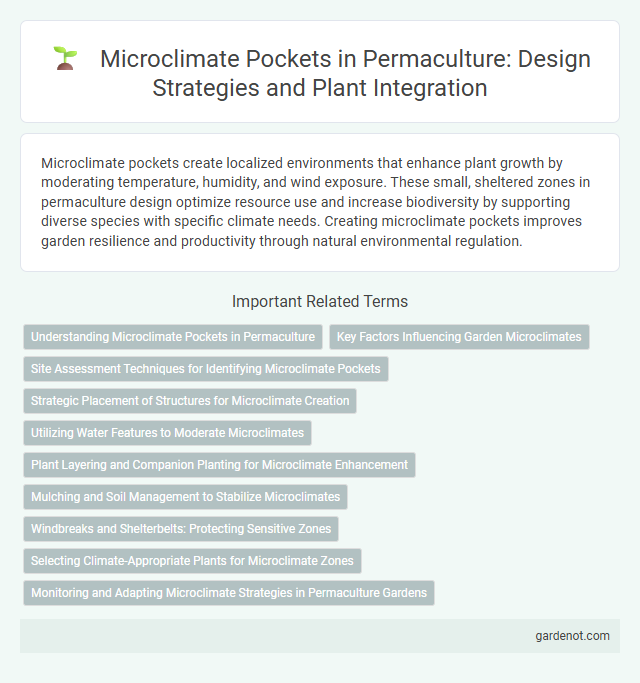Microclimate pockets create localized environments that enhance plant growth by moderating temperature, humidity, and wind exposure. These small, sheltered zones in permaculture design optimize resource use and increase biodiversity by supporting diverse species with specific climate needs. Creating microclimate pockets improves garden resilience and productivity through natural environmental regulation.
Understanding Microclimate Pockets in Permaculture
Microclimate pockets in permaculture are localized areas where temperature, humidity, wind, and sunlight differ significantly from the surrounding environment, creating unique growing conditions. These microclimates can be influenced by factors such as topography, vegetation, water bodies, and built structures, enabling diverse plant selection and improved yields. Understanding the specific characteristics of microclimate pockets helps permaculture designers optimize site planning and resource use for sustainable, resilient ecosystems.
Key Factors Influencing Garden Microclimates
Microclimate pockets in permaculture gardens are shaped by key factors including sunlight exposure, wind patterns, and soil moisture levels. Vegetation density, topography, and proximity to water bodies further influence temperature variations and humidity within these microenvironments. Understanding these elements enables optimized plant placement and resource efficiency in sustainable garden design.
Site Assessment Techniques for Identifying Microclimate Pockets
Site assessment techniques for identifying microclimate pockets in permaculture include detailed observation of sunlight patterns, wind flow, soil moisture, and temperature variations. Utilizing tools such as infrared thermometers, anemometers, and soil probes enables precise data collection to map microclimate zones. Geographical features like slopes, vegetation, and structures are analyzed to understand how they influence localized climate conditions.
Strategic Placement of Structures for Microclimate Creation
Strategic placement of structures in permaculture design harnesses natural elements to create beneficial microclimate pockets that enhance plant growth and conserve water. Utilizing features such as earth berms, windbreaks, and shade trees positioned to block harsh winds and maximize sunlight exposure stabilizes temperature and moisture levels. This targeted arrangement fosters diverse ecosystems, improves soil health, and supports resilient agricultural productivity.
Utilizing Water Features to Moderate Microclimates
Water features such as ponds, swales, and small streams play a crucial role in moderating microclimates by stabilizing temperature fluctuations and increasing local humidity in permaculture systems. These elements absorb heat during the day and release it slowly at night, creating a more favorable environment for plants and beneficial insects. Incorporating water bodies strategically enhances resilience against frost, drought, and heat stress, promoting biodiversity and productivity within the microclimate pocket.
Plant Layering and Companion Planting for Microclimate Enhancement
Plant layering in permaculture creates microclimate pockets by arranging multiple strata--from canopy trees to ground covers--that regulate temperature, moisture, and wind exposure, boosting ecosystem resilience. Companion planting enhances these pockets by pairing species that improve soil fertility, deter pests, and optimize light and humidity, such as nitrogen-fixing legumes near water-demanding vegetables. These integrated strategies increase biodiversity, microhabitat stability, and overall productivity within permaculture systems.
Mulching and Soil Management to Stabilize Microclimates
Mulching enhances soil moisture retention, reduces temperature fluctuations, and protects root zones, creating stable microclimate pockets essential for plant health in permaculture systems. Incorporating organic mulches such as straw, wood chips, or composted leaves improves soil structure, promotes beneficial microbial activity, and aids in nutrient cycling. Effective soil management through mulching supports resilient ecosystems by mitigating erosion, maintaining humidity, and fostering consistent thermal conditions that optimize plant growth.
Windbreaks and Shelterbelts: Protecting Sensitive Zones
Windbreaks and shelterbelts are essential features in permaculture design for creating microclimate pockets by reducing wind speed and protecting sensitive zones from harsh environmental conditions. These elements improve soil moisture retention, enhance plant growth, and increase biodiversity by creating a stable, sheltered environment. Strategic placement of native trees and shrubs in shelterbelts optimizes wind protection and supports ecological balance within the permaculture system.
Selecting Climate-Appropriate Plants for Microclimate Zones
Selecting climate-appropriate plants for microclimate pockets enhances growth by matching species to localized temperature, humidity, and sunlight conditions. Plants such as drought-tolerant succulents thrive in hotter, drier zones, while shade-loving ferns and mosses perform better in cooler, shaded areas. Understanding microclimate zones enables permaculture practitioners to optimize biodiversity and resilience within garden ecosystems.
Monitoring and Adapting Microclimate Strategies in Permaculture Gardens
Monitoring microclimate pockets in permaculture gardens involves regular observation of temperature, humidity, wind patterns, and soil moisture to understand localized environmental variations. Adapting microclimate strategies includes using shade structures, windbreaks, water features, and plant selection tailored to enhance beneficial conditions or mitigate stress factors. Employing tools like data loggers and soil sensors ensures precise adjustments, promoting plant health and maximizing productivity within microclimate niches.
Microclimate pocket Infographic

 gardenot.com
gardenot.com